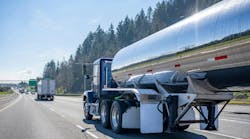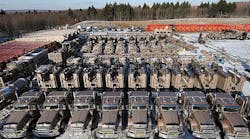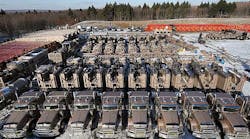For Don Luft, looking back makes it easier to look forward.
As an 18-year old, he got his feet wet in the oil and gas well servicing business by driving a Kenworth truck for Nowsco Well Service Ltd. Over the years, his truck took him into some inhospitable areas of the oilfields. He can even lay claim to being an ice road trucker as he traversed many miles of frozen river and lake roads as well as what seemed like endless miles of frozen muskeg throughout western Northern Canada.
“Life's lessons,” says Luft, who 38 years later serves as president and chief operating officer for Trican Well Service Ltd, one of North America's largest providers of oil and gas pumping services. “When Murray Cobbe and I bought out one of the three partners of Trican in 1996, we took over a small oilfield servicing company that had been around since 1979. But, we knew we didn't want to stay small and in December of that year, we went public to raise capital to grow our business. We saw a great deal of opportunity outside of where we were headquartered in Lloydminster (on the border of Alberta and Saskatchewan), and diversified into western Canada and internationally. Over the years, we've invested approximately $2 billion in new equipment and facilities and that investment has paid our shareholders back tremendously.
“When we bought the company, we had less than 50 people. Today, we're international and have 5,700 employees. In fact, we're the largest pressure pumping company not only in Canada, but also in Russia.”
Seven countries
In all, Trican has oilfield service operations in seven countries. Besides Canada, Russia, and the United States, Trican serves clients in Kazakhstan, Algeria, Australia, and Saudi Arabia.
Trican offers an impressive portfolio of services that include fracturing, acidizing, and cementing. The company takes pride in serving customers with best-of-class equipment and technology operated safely by highly trained and reliable staff.
Fracturing is the process used in the shale plays where the natural flow of the oil and natural gas is restricted. Fluid is pumped into a well at sufficiently high pressure to fracture the formation. A proppant (sand or ceramic material) is then added to the fluid and injected into the fracture to prop it open, thereby permitting the hydrocarbons to flow more freely into the wellbore.
Trican has designed a substantial fleet of mobile fracturing equipment that is tailored to the regions in which it operates. Equipment includes combination fracturing units; mobile data acquisition and control centers; blenders used to mix powders, chemicals, and liquids; low-profile frack pumpers that were a first of their kind in the industry; chemical addition units, hydration units, and proppant storage and conveying equipment.
Acid treatment
Trican specialists have developed specific acid systems for geologic formations in every area in which the company operates. The company has successfully completed acid treatments in many of the more challenging regions, such as those with formations containing large amounts of wax and asphaltene. Trican has designed acid chemistry that not only prevents the precipitation of these compounds, but also leaves wells clean and undamaged.
“Hydrochloric is the primary acid we handle in bulk,” says Ben Mikulski, Trican corporate manager of equipment standards and R&M services. “We're shifting to fiberglass-reinforced plastic (FRP) acid tankers, because we saw too much corrosion in the steel acid tanks we purchased in the past.”
Cementing is one of the most important oilwell services, according to Luft. It is the only way to ensure complete zonal isolation and aquifer protection. Without it, the well may never reach its full production potential, and liquids from one zone could interfere with another. Trican performs the following cementing operations: surface casing, intermediate casing, production casing, liner jobs, cement plugs, and remedial jobs.
Cementing operations are supported by a fleet of dry bulk and pneumatic trailers, most supplied by Heil Trailer International. Bulkers range in capacity from 1,000 cubic feet to 1,600 cubic feet. The company also has pigs and other portable dry bulk storage units that can be staged at well sites. In addition to cement, dry bulk and pneumatic trailers are used to transport frack sand and powdered oilfield chemicals.
Trican also services oilwells with cryogenic nitrogen and carbon dioxide. Nitrogen is pumped into a wellbore to improve the safe recovery of introduced and produced fluids, while reducing the potential of formation damage. CO2 is used to energize a stimulation fluid in both fracturing and acidizing applications. Trican operates its own cryogenic tank trailers for transport and storage of the industrial gases.
All together, Trican runs more than 500 tank trailers and dry bulkers in the United States and Canada. The company also has 184 product storage units in the field in the two countries.
Critical vehicles
Trucks and tractors are critical to the success of the Trican operation, and Luft knew from his 15 years of driving that the vehicles had to be tough and durable. “When we acquired Trican, the company was using a brand of truck that wasn't going to attract drivers,” he says. “We wanted Kenworths and the early history I had with the brand — its reliability and respect amongst drivers — came into play. We knew the truck was a great well servicing unit. If I drove a truck, I wanted a real truck, a Kenworth.”
Trican placed its initial truck order with GreatWest Kenworth for W900s and T800s. Over the years, the T800 became Trican's truck of choice for its excellent versatility, reliability and maneuverability. The latest order for T800s includes 62-inch AeroCab sleepers. Most are spec'd with 485- to 500-hp Cummins ISX15 engines driven through 18-speed transmissions with tandem drive axles. Some are spec'd with tridem drives to tackle the additional weights and traction requirements of the off highway applications including mountainous terrain, snow, ice, and mud.
All told, Trican now operates close to 1,500 trucks (along with the workhorse T800, there is a smattering of Kenworth C500s and medium-duty trucks) throughout its worldwide system. “In Russia, we're using the C500 in a 6x6 configuration with body-mounted pumpers and tractor services for specialized equipment applications, and we are also using our standard T800 tractors,” said Luft. “In the deserts of Algeria, we're running the T800 with large floatation tires.”
According to Luft, some of the Kenworths begin their life in North America servicing oil wells before getting transferred overseas, while others were purchased new and shipped over for service.
“We're running our Kenworth trucks hard, but they have a long productive life,” said Luft. “Our off-road trucks and tractors will normally put on about 60,000 miles a year, and we keep them up to 15 years. They'll haul anywhere from 35,000 to 100,000 kilograms (77,000 to 220,000 pounds) gross combination — mostly hauling pneumatic trailers or low boys with fracturing pumps, coil tubing, or other specialized equipment. Our road tractors typically run double those miles per year and stay on board for 10 years prior to trade in. How long we keep a truck really is dependent upon the application.”
Here is a list of Trican's Kenworth trucks, how they are used, and how they are typically spec'd for the oilfield:
C500: The Kenworth C500 is used in Canada and Russia as a tractor as well as a single “cementer chassis.” Delivering cement to a well operation, these trucks come equipped with automatic transmissions and straight-through frames with FEPTO. The tractors in Russia are ordered in 6x6 and 6x4 configurations.
W900: The Kenworth W900 chassis is used as a stiff boom picker truck. It comes equipped with 485-hp engine, 18-speed transmission, with 20,000-lb front axles and 46,000-lb drive axles.
T370s: Kenworth T370s are used for service bodies. They have PACCAR PX-6 engines rated at 260-hp driven through 9-speed transmissions and feature 12,000-lb front axles and 21,000-lb rear axles.
Looking good
No matter the application or configuration, the vehicles look good. “People see our color — DuPont Imron's Mocha Frost — and know it's our truck,” says Luft. “Color selection was very important to us, and I remember flipping through the color samples when we purchased our first Kenworths. We wanted to stand out and be highly recognizable. The trucks represent our company. It's what people see.”
What people have been “seeing,” but more importantly “receiving” has fueled Trican's business. “What we feel separates us is our fireman mentality,” says Luft. “Our business is so demanding. It's 24 hours a day, 7 days a week. We have to go to work at a drop of a hat. No excuses. It takes a special breed of truck driver to work with us, and our people are up to the challenge. We have a very low turnover rate. I think that goes back to our formula: operate a quality company, using quality equipment, and you can hire and retain quality people.”
Luft says he still has his class 1 license, something he displays with pride. “I started as a truck driver and still have driving in my blood,” he says. “I'm very proud of what we've accomplished here at Trican. We strive to be the best service provider in the industry. And we feel all of our services — technically and operationally — provide tough competition. Transporting our equipment and our image up and down the roads of the oil patch is an important part of who we are and our drivers require a dependable piece of equipment that they can use and be proud of. It's been an important part of our formula for success.”
















